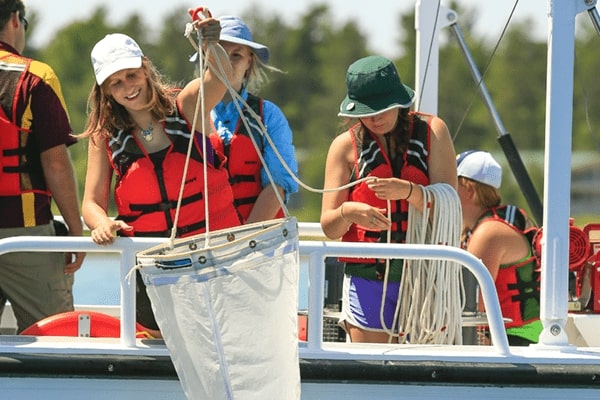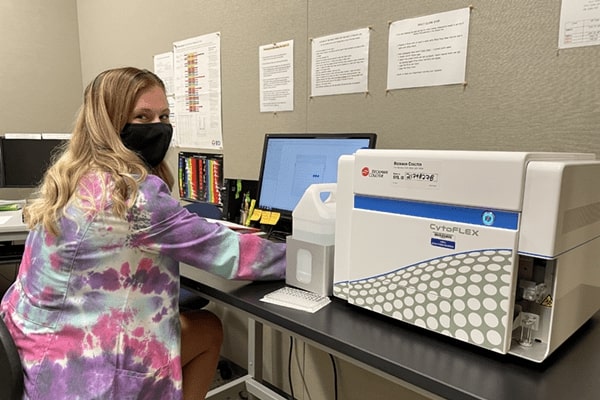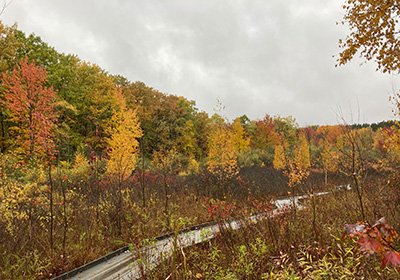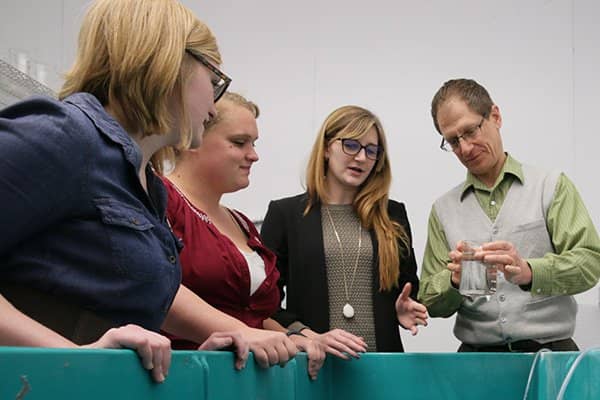Biology Beyond the Classroom
Hands-on learning starts with exceptional spaces and experts in the field. Our state-of-the-art facilities are built to support discovery at every level and our faculty have the expertise to guide our students to successful careers. Biology students at CMU have access to a range of specialized resources, including the CMU Biological Station on Beaver Island, where immersive field courses and ecological research thrive. The CMU Greenhouse and Herbarium offer living and preserved plant collections for botanical study, while the Flow Cytometry and Microscopy Facilities provide advanced tools for cellular and molecular analysis. The Vivarium supports the study of aquatic organisms, plants, and ecosystems, giving students firsthand experience with freshwater life and aquatic research techniques, and plant biotechnology. Just minutes from campus, Neithercut Woodland and Veit's Woods serve as a living laboratories for forest ecology and environmental research. Whether you're analyzing molecules and cells, studying plant systems, advancing biotechnology, or conducting fieldwork, these facilities give you the tools to ask deeper questions and find meaningful answers.
Modern research labs
Students gain hands-on experiences working in modern research labs to enhance their skills in all areas of biology from molecules to cells to conservation biology and to ecosystems.
CMU Biological Station (CMUBS)
 Situated on Beaver Island in Lake Michigan, CMUBS is a unique field station where students explore island ecology, aquatic systems, and environmental science through field-based courses and summer research. It's a one-of-a-kind setting for immersive, place-based learning.
Situated on Beaver Island in Lake Michigan, CMUBS is a unique field station where students explore island ecology, aquatic systems, and environmental science through field-based courses and summer research. It's a one-of-a-kind setting for immersive, place-based learning.
CMU Greenhouse
 The CMU Greenhouse is a teaching greenhouse featuring several rooms displaying plants from different climates and regions from around the world. Used by Biology classes, students gain hands-on experiences in plant growth and adaptations. The greenhouse also employs students who gain real-world experiences in running a greenhouse.
The CMU Greenhouse is a teaching greenhouse featuring several rooms displaying plants from different climates and regions from around the world. Used by Biology classes, students gain hands-on experiences in plant growth and adaptations. The greenhouse also employs students who gain real-world experiences in running a greenhouse.
CMU Herbarium
 With more than 30,000 preserved plant specimens, the herbarium serves as a vital resource for studying plant diversity, taxonomy, and regional flora. Students and faculty use the collection to conduct research on plant distribution, climate impact, and historical biodiversity.
With more than 30,000 preserved plant specimens, the herbarium serves as a vital resource for studying plant diversity, taxonomy, and regional flora. Students and faculty use the collection to conduct research on plant distribution, climate impact, and historical biodiversity.
Flow Cytometry Facility
 This high-tech lab enables precise cell sorting and analysis, key tools for research in immunology, microbiology, genetics, and beyond. Students have access to cutting-edge equipment used in real-world biomedical and cellular research.
This high-tech lab enables precise cell sorting and analysis, key tools for research in immunology, microbiology, genetics, and beyond. Students have access to cutting-edge equipment used in real-world biomedical and cellular research.
Microscopy Facility
 From fluorescence to electron microscopy, this facility allows students to explore structures at the microscopic and ultrastructural level. The facility supports teaching and research in cell biology, biotechnology, developmental biology, material sciences, and more.
From fluorescence to electron microscopy, this facility allows students to explore structures at the microscopic and ultrastructural level. The facility supports teaching and research in cell biology, biotechnology, developmental biology, material sciences, and more.
Neithercut Woodland
 Just a short drive from campus, this 250-acre forest provides an outdoor classroom for studying forest ecology, conservation, and environmental change. Students participate in long-term monitoring projects and gain practical skills in field biology.
Just a short drive from campus, this 250-acre forest provides an outdoor classroom for studying forest ecology, conservation, and environmental change. Students participate in long-term monitoring projects and gain practical skills in field biology.
Vivarium
 Home to a variety of freshwater species and plants, the vivarium supports research and teaching in aquatic ecology, behavior, physiology, and plant biotechnology. Students work directly with live organisms in a controlled setting, studying everything from fish development to ecosystem interactions to advances in biotechnology.
Home to a variety of freshwater species and plants, the vivarium supports research and teaching in aquatic ecology, behavior, physiology, and plant biotechnology. Students work directly with live organisms in a controlled setting, studying everything from fish development to ecosystem interactions to advances in biotechnology.
